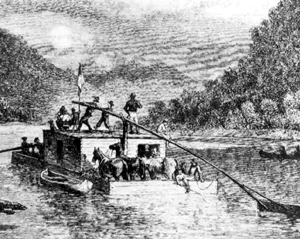
John Donelson
John Donelson, land speculator and early settler of Middle Tennessee, led over one hundred settlers on a tortuous water journey to the Cumberland settlement during the winter of 1779-80. Donelson was one of the earliest settlers of Pittsylvania County, Virginia, although the date of his arrival in Virginia is not known. His father and grandfather were involved in planting, commerce, and shipping. An educated man for his time, Donelson was the surveyor for Pittsylvania County from 1767 to 1779. He was a member of the House of Burgesses from 1769 to 1774. In 1771 he was appointed to survey the state line and found that three settlements thought to be in Virginia were actually within the boundaries of North Carolina. In 1775 he became county lieutenant, with rank of colonel, and served in campaigns against the Overhill Cherokees. As a result of Donelson's survey of the Cherokee line, he acquired a large land claim west of that line and attended the Cherokee treaty signing at Fort Patrick Henry, near the Long Island of the Holston, in 1777.
Richard Henderson selected Donelson and James Robertson to lead settlers into this Cumberland River region. Robertson made plans for an overland voyage while Donelson led another group along a water route. Donelson and approximately thirty families embarked from Fort Patrick Henry on December 22, 1779. Their boat, the Adventure, accommodated several families, household goods, and supplies necessary to sustain a settlement in a new land. At the mouth of the Clinch River, another group of emigrants joined Donelson's party. He led this flotilla of thirty or so canoes, flat boats, and dugouts on an expedition traversing the Holston, Tennessee, Ohio, and Cumberland Rivers.
The fleet carried a large number of women and children. Donelson's own large family, including his wife Rachel Stockley, their children, and approximately thirty African American slaves, were among the travelers. One of Donelson's children was his thirteen-year-old daughter Rachel, who would become the wife of Andrew Jackson. Others in the party included James Robertson's wife, Charlotte, and five of their eleven children.
Donelson kept an account of his historic journey and of the hardships they endured. On December 22 he made his first entry in his “Journal of a Voyage, intended by God's permission, in the good boat Adventure, from Fort Patrick Henry, on Holston river to the French Salt Springs on Cumberland River.” (1) During the four-month voyage, the hardy pioneers suffered Indian attacks, a smallpox outbreak, hunger, exhaustion, extreme cold, swift currents, and treacherous shoals.
On April 24, 1780, Donelson's party reached the end of their thousand mile journey and were finally reunited with family and friends at the Big Salt Lick (now Nashville). Within a week of Donelson's arrival, Henderson prepared the Cumberland Compact, of which Donelson was the fifth signer.
Donelson, his family, and slaves made camp at a tract of land along the rich river bottom of Stones River. He named this site Clover Bottom and planted corn and the first cotton crop to be raised in the area. In July the Stones River flooded, completely covering the bottomlands where Donelson had planted his corn and cotton. This disaster, as well as recent reports of Indian attacks in the Clover Bottom section, prompted Donelson to move his family to the relative safety of nearby Mansker's Station.
Once the floodwaters receded, Donelson learned that his corn and cotton crops at Clover Bottom had matured and decided to attempt to save them. A party composed of his son, Captain John Donelson Jr., Abel Gower Jr., and several others worked for several days to harvest the valuable crops. After gathering the corn, the Gower boat started down the river and was soon fired upon by a party of Chickamaugas. These attacks on the settlements, along with the serious shortage of food, prompted Donelson to remove his family and slaves to a more secure position in Kentucky.
Donelson continued his business dealings, traveling frequently between the lands of Kentucky, Virginia, and Tennessee. While returning from Virginia and Kentucky on business in 1785, Donelson learned that his family had returned to the Cumberland settlement. On his journey to Mansker's Station he was fired upon and died along the banks of the Barren River.
Suggested Reading
A. W. Putnam, The History of Middle Tennessee, or Life and Times of James Robertson (1859); Tennessee Historical Commission, Three Tennessee Pioneer Documents (1964)



